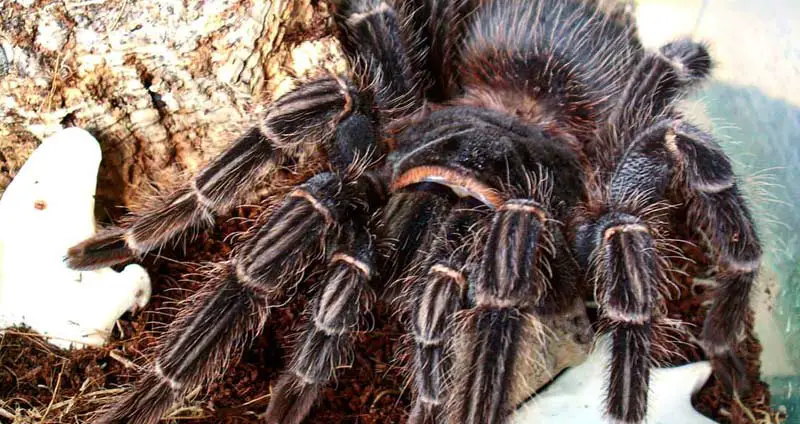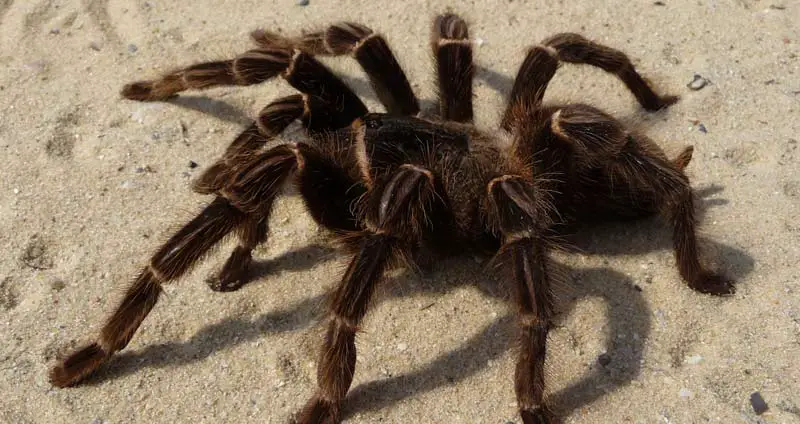Within the pet trade, there are always people looking for the biggest, coolest, and most expensive animals to keep. With all of the different types of tarantulas out there, there’s bound to be some that stick out.
Lasiodora parahybana, or the Brazilian Salon Pink Birdeater, is one of those tarantulas.
This guide is intended to provide a comprehensive care sheet for this fantastic tarantula, telling you what to expect and how to properly keep it.
Table of Contents
Lasiodora parahybana Care Sheet
Common Name |
Brazilian Salmon Pink Birdeater |
Species Type |
New world terrestrial |
Habitat |
Found in Brazil with a habitat that mostly consists of forests that are warm and humid year-round. |
Growth Rate |
Fast growth rate. Can grow several inches in a single year. |
Adult Size |
Females reach a legspan of about 10 inches, with males measuring slightly smaller. |
Lifespan |
Females are known to live up to 20 years, while males only live for about 5 years. |
Enclosure |
The enclosure needs to be very long and wide as lots of floor space is essential. 4-6 inches of substrate should be provided to allow for burrowing. It should also be complimented with a hide and water dish. |
Temp/Humidity |
75°F to 80°F with about 65% to 75% humidity. |
Diet |
Excellent eater that always attacks prey with a vengeance. Can eat around 7 adult crickets per week or 2 dubia roaches. |
Temperament |
Quite bold but not aggressive or defensive. Tends to not be scared easily but prefers to run and hide over fighting. Great display species. |
Experience Level |
Beginner – While it’s a big tarantula, it’s friendly and quite easy to care for. No more difficult to keep than any other species. |
Average Cost |
Slings ~ $25, Males ~ $50, Females ~ $80+ |
Lasiodora parahybana Appearance
The appearance of this tarantula is one of the main reasons why it’s so popular! It may not have the beautiful coloration of a tarantula like Chromatopelma cyaneopubescens, but it’s definitely got an impressive size!
Like other bird-eating tarantulas, this species grows larger than your average tarantula.
Specifically, you can expect this tarantula to reach a legspan of about 10 inches when fully grown! It also reaches this size quite quickly, growing from a spiderling to a juvenile in just a year.
In terms of coloration, it’s still a nice tarantula to look at. It has a dark, fat body that’s quite large in relation to its legs. This dark coloration works to contrast the salmon-pink hairs all over its body, giving it a nice subtle pop of color (and yielding it its name).
So, this isn’t the largest tarantula ever, and it isn’t the most beautiful, but it’s a perfect mix of the two. This makes it very appealing for new and experienced keepers alike.

Lasiodora parahybana Temperament
Not only is this tarantula species very large, but it’s also got a large personality to go along with it! This may seem to contrast its intimidating appearance, but it’s definitely true.
Its overall agreeable demeanor and calm temperament make it an awesome tarantula for inexperienced tarantula keepers.
Lasiodora parahybana is a new world tarantula, which are tarantulas that are known for being quite calm, friendly, and much less aggressive than old world tarantulas.
When this tarantula is threatened, it prefers to run and hide in its burrow instead of being aggressive. As a new world tarantula, it possesses the ability to kick urticating hairs at predators.
However, owners report that they almost never see their L. parahybana flick hairs.
Additionally, while this tarantula does love to burrow, it doesn’t stay in its burrow for long periods of time like the fossorial Chilobrachys sp. Electric Blue. Therefore, it’s a great display tarantula for people that love to enjoy the splendor of their tarantulas.
Note that while it is a friendly tarantula, it’s still not recommended that you handle your tarantula, especially with its large size. The risks simply don’t outweigh the rewards. Fortunately it’s easy to appreciate this tarantula in other ways.
Housing Lasiodora parahybana
If you’re planning on bringing home a Brazilian Salmon Pink tarantula, you need to make sure that you’re supplying it with a proper enclosure. Fortunately, this is quite easy to do.
All that you need to do is provide it with a sizable enclosure, fill it up with a few essentials, then keep the internal climate consistent.
Optimal Enclosure
While Lasiodora parahybana has specific environmental needs, those needs are not difficult to meet. To begin with, these are terrestrial tarantulas that need to burrow, so it’s essential that their enclosure has plenty of floor space with not a lot of extra height.
This is a very large species, so it needs an enclosure that lets them move around comfortably — about 2-3 times their leg length in length and width.
The Exo Terra 18″ x 18″ x 12″ glass terrarium works great for fully-grown adults due to its large size, nice accessibility, and overall quality construction.
This particular enclosure is wide enough to provide your tarantula with plenty of space to roam around and create a burrow and webbing, but it’s not too tall to where it could pose a hazard if your tarantula tries to climb.
Enclosure Decorations
The inside of the enclosure needs to have a few accessories in order for Lasiodora parahybana to feel as comfortable as possible, but doing this isn’t difficult at all.
First and foremost, you need to layer about 6 inches of moisture-retaining substrate along the floor of the enclosure — coconut fiber substrate is great for this.
This substrate allows the L. parahybana to create intricate burrows, and it also works to keep the enclosure clean and maintain consistent humidity levels.
On top of the substrate, you’ll want to provide a cork bark hide and a water dish. Both of these are essential.
The cork bark hide allows your tarantula to escape from the world when it’s feeling scared or stressed, and the water dish works to prevent dehydration in your spider.
Once you’ve added those things, you can get a bit creative.
Add some sphagnum moss, fake plants, and a few sticks and rocks to create a diverse enclosure.

Enclosure Temperature/Humidity
Lasiodora parahybana is endemic to Brazilian forests where it’s warm and humid all year. Therefore, their enclosure needs to reflect that to some extent.
The optimal temperature for this species is around 75°F to 80°F. For most people, this is right around room temperature, so extra heating isn’t needed.
If your house drops below this range frequently, you need to use either a space heater or a gentle heat lamp that doesn’t emit light as a supplemental heating source.
As for humidity, aim for around 65% to 75%. Maintaining this range is quite simple with a consistently-filled water dish and regular misting of the substrate.
It’s recommended that you place a thermometer/hygrometer in your Lasiodora parahybana‘s enclosure so that you can monitor environmental conditions and make small changes as needed.
Diet
This large tarantula comes with a large appetite, believe it or not! While it’s a bird-eating tarantula, you don’t need to feed it birds to keep it satisfied.
About 7 adult crickets per week are enough to keep it filled, and 2 dubia roaches will also do the trick. You can diversify their diet with mealworms and the occasional pinky mouse, too.
One fun fact about this species is that its a ravenous eater. It will quickly attack and subdue its prey, putting on quite a show. They utilize their hide to wait and ambush prey as it walks by! Therefore, they don’t produce a lot of webbing.
The fact that it’s almost always out in the open and attacks food aggressively makes it a very fun tarantula to own.
Health Concerns
There’s nothing special about Lasiodora parahybana in terms of health problems or special considerations. It is susceptible to standard tarantula illnesses like parasites/mites and dehydration, but both of those ailments are easy to prevent and fix.
One issue that all tarantula owners are likely to run into at one point is molts becoming stuck. If this happens, it could be life-threatening if you don’t take action to help.
Fortunately, it’s pretty easy to help in this case as there are many detailed guides available online.
Lasiodora parahybana For Sale & Price
Learning about this tarantula, you may think that it would be quite expensive! It’s large, unique, and has a great personality. That’s wrong, though. This is a surprisingly affordable tarantula — one of the main reasons why it’s so popular!
Many online marketplaces and breeders have Lasiodora parahybana for sale. Spiderlings sell for only around $25, while unsexed juveniles go for around $40. Sexed adult males are about $50, while females are $80+.
Prices can vary greatly, but this is overall a very affordable tarantula.
So, if you’re looking for a tarantula that demands attention with its size and holds that attention with its great personality, this is a perfect tarantula for you. It’s easy to afford, easy to care for, and even easier to obsess over.

